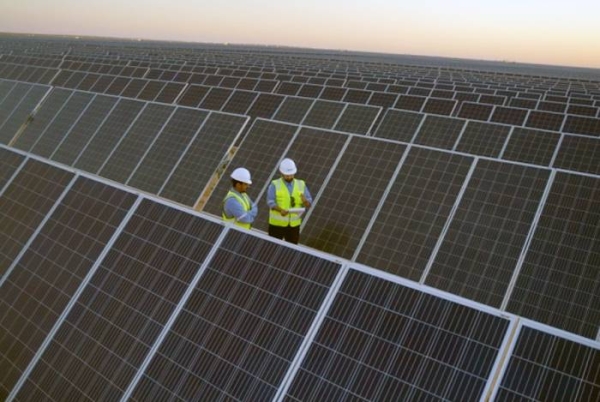
By Nava Akkineni
The opening of the Sakaka solar power plant coupled with the announcement of seven new solar power projects as part of the new Saudi Arabia Green initiative makes a powerful statement that one of the world’s leading oil producers is absolutely committed to being a leader in the global fight against climate change.
The country plans to employ a healthy mix of solar, wind, green hydrogen and nuclear to eliminate more than 130 tons of carbon emissions using clean energy technology. But solar power will serve as the core pillar of Saudi Arabia’s commitment to producing 50 percent of all electricity in the nation through renewable energy sources.
Solar energy is expected to represent nearly 70% of Saudi’s future clean energy capacity. A recent report by the Riyadh Chamber showed the current pipeline of solar projects in the Kingdom represents SR60 billion ($15.9 billion) in project investments and that at least half of all families in the country want to use solar in their homes.
The Saudi commitment to and investment in climate action will do far more for the country than just combat climate change. It will build the foundation of a new Green Economy that will reshape the country’s economic future and play a key role in achieving Vision 2030 economic objectives.
Investment in clean energy is an essential component of Saudi’s economic diversification, industrialization and job creation strategy. That’s why development of renewable energy technology, infrastructure and facilities represents a core strategic pillar of the new ‘Made in Saudi’ comprehensive manufacturing and industrialization strategy.
Yasser Al-Rumayyan, governor of Saudi Arabia’s Public Investment Fund (PIF) which owns 50 percent of ACWA Power, one of the nation’s leading energy companies that is the owner and developer of the Sakaka solar plant, said the opening of the plant “embodies our commitment to invest in the sectors that will shape the future of the global economy.”
Saudi Arabia, which ranks 6th globally in potential capacity for solar energy, is far from the only GCC or MENA country relying on the power of the sun for a new clean energy and green economy strategy. Today solar energy represents 94% of the current installed capacity of renewable energy across all GCC countries, with most of that coming from large utility-scale solar PV projects.
Solar also represents 91% of the potential power generation currently in the pipeline in the GCC, according to the International Renewable Energy Agency (IRENA) “Renewable Energy Market Analysis: GCC 2019.”
There are a number of reasons why solar is dominating the renewable energy mix across the region. It starts with the dramatic decline in the cost of solar energy production, with cost per kilowatt hour falling from $0.5 to $0.135 in the just the last 5 years. That’s a near 75% reduction in energy production costs.
This rapid cost decrease directly correlates to an increase in solar efficiency ratings, with new solar plants operating at up to 99% efficiency. Contributing to improved efficiency is solar power plants becoming smarter and producing far more energy than ever before thanks to solar innovation.
Solar innovation is key to improving performance and efficiency of solar plants not only in Saudi Arabia but across the GCC and MENA region. This is a region blessed with abundant sunshine, which is obviously an advantage for solar. But it’s also a region where the solar plants are often developed in desert conditions.
Bifacial technology being used in many new solar plants across the region captures direct sunlight on one side of a solar panel and reflective sunlight on the other. The Nextracker solar tracking software uses artificial intelligence and machine learning tools to squeeze more energy from the system, maximizing the capture of sunlight while integrating advanced digital operations and maintenance and robotic cleaning solutions to minimize the operating costs.
By 2030, based on the current national commitments and project plans, GCC countries are on track to save the equivalent of 354 million barrels of oil through the deployment of renewables.
That represents a 23% reduction in oil consumption that would come with it the creation of more than 220,000 jobs. It would also reduce the power sector’s carbon dioxide emissions by 22% while cutting water withdrawal in the power sector by 17%.
Nextracker is partnering with a wide range of government regulators, owner-operators and technology companies across the region to bring to life some of the largest and most technologically advanced solar projects in the world that will contribute to achieving this vision.
That includes ACWA Power’s Sakaka plant as well as the Mohammed Bin Rashid Al Maktoum Solar Park in Dubai and other projects in UAE, Benban Solar Park in Egypt and the Sohar Solar Plant in Oman.
These projects, along with many others across the region, will play a significant role in realizing national decarbonization pledges while forming the foundation of a new sustainable green energy economy. They will deliver far-reaching environmental and socio-economic benefits and measurable impact for years to come while helping provide for and protect the wellbeing of future generations.
And the Saudi Green and Middle East Green Initiatives are poised to lead the way for the region to cut carbon dioxide emissions by 60 percent in the years ahead.
— The writer is vice president emerging markets Nextracker